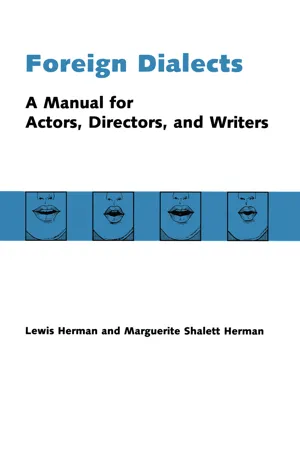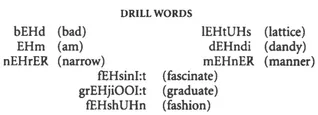![]()
CHAPTER TWO
The Cockney Dialect
The Cockney Lilt
Since most of the Cockney vowels are elongated into diphthongs and triphthongs, the resulting rhythm tends to be choppy. This effect is heightened also by both the glottal stops, with which the dialect abounds, and by the weak attack on those consonants that are sounded. The slow tempo of the Cockney dialect has a leavening effect on the erratic rhythm.
Generally speaking, Cockney is delivered in a high-pitched voice. The vowel elongation brings with it a nasal whine that is further typical. These two traits are the result of the Cockney's habit of speaking with his mouth constantly half-open (he is adenoidal, remember) and with a slack movement of his jaws.
There is a great deal of inflection in the Cockney dialect, especially with certain vowels. The long "o" for example becomes "AOW" (this is discussed fully in the section on "Vowel Changes") and often this triphthong takes several notes.
One of the most widely used patterns in question sentences is:
The first word "AW (are) would be spoken higher than in American. The next two words, "yuh" (you) and "gAOWin'" (going) would then be given declining notes. The lowest note would be reached with "A," the first letter of the triphthong "AOW." The last part of the triphthong would be infected upward on a glide until the highest note is reached with "m."
In a simple declarative sentence, the tonal pattern would be as follows:
Emphasis
Stress, in Cockney, is laid mostly on the drawn-out, diphthongized vowels, of which there are many. In the sentence, "tI:k THuh bliOOmi nAW sAOWm." (take the blooming horse home), the emphasis is placed on the boldface syllables. The "I" in "tI:k" is pronounced "AH-EE" and is further discussed in "Vowel Changes." Sentence emphasis is similar to American, but vowels within words should be emphasized according to their length; that is, triphthongs first, diphthongs next, and monothongs last.
Vowel Changes
"AY".... as in "take," "break," "they," etc.
The Cockney changes this long a (AY) to long "i"(I:). The sound of this "I:" is "AH-EE" with the stress on the initial "AH" sound. The word "take" would be pronounced "tAH-EEk" but for the sake of simplicity the symbol "I:" will be used, as in "tI:k." The colon (:) after "I" signifies elongation.
"UH".... as in "alone," "sofa," "final, etc.
This "UH" sound of "a" in American is written "ER" in Cockney and is pronounced like the "ur" of "curb" with the "r" silent. In a great many books and plays, a Cockney character is written as saying "erlong" or "erbout" although the "r" is used only for flavoring and should not be sounded.
"AH".... as in "father ""arm," "park," etc.
The sound of "AW": is always given to this "AH," as in the word "fAWTHER" (father). The Cockney "AW:" is deeper and richer than the American sound which comes from the middle of the mouth. The Cockney "AW" comes from far back (or down) in the throat and the lips are pursed instead of being slightly opened and rounded. This is an important variance and should be practiced for perfection.
"A:".... as in "ask," "draft," "laugh," etc.
In general, the Cockney pronounces this A:" as "AW," as in "AW:sk" (ask). But because of the infiltration of the British dialect into Cockney, this "A:" is also given an "AH" sound, as in "AHsk" (ask). The latter form is suggested. The former may be used when a varying character delineation is necessary.
The beginner in dialect study may be somewhat confused by the difference in pronunciation of words like "ask" (AHsk) and "bad" (bEHd). There is no hard and fast rule which can be given for this puzzling variance. Aside from individual preference, there is also a sectional preference. It will be remembered in Pygmalion that Shaw brought this point up quite sharply. Certain sections adhere to certain pronunciations. The following general rules are given to help clear up most of the doubt.
- IN COCKNEY, WHEN SHORT "a" IS FOLLOWED BY "f," "ft," "nch," "nce," "nt," "sk," "sp," "ss," "st," AND "th" IT SHOULD BE PRONOUNCED AS "AH."
However, when "th" is followed by a vowel, the preceding short "a" usually becomes "EH," as in: "pEHthAWlUHji" (pathology). But, when "th" is final, or followed by a consonant, the short "a" follows the rule and becomes "AH," as in "pAHth" (path),"pAHthwI:" (pathway).
A few other examples of Rule 1 are: "dAHns" (dance), "fAHst" (fast), "brAHntch" (branch), and "grAHsp" (grasp).
- 2. ALL THREE-LETTER WORDS USING SHORT "a" SUBSTITUTE "EH."
The exceptions to this rule are the words: "AHft" (aft), "AHsk" (ask), "AHsp" (asp), and "AHs" (ass).
- 3. MOST WORDS USING SHORT "a" BEFORE A SINGLE FINAL CONSONANT, OR A SINGLE CONSONANT SOUND FOLLOWED BY A VOWEL, SUBSTITUTE "EH."
Examples of this rule are found in the words: "kEHb" (cab), "pEHkuht" (packet), "mEHth'mEHtiks" (mathematics), and "'EHm" (ham).
- 4. IN GENERAL, WORDS IN WHICH SHORT "a" IS FOLLOWED BY THREE DIFFERENT CONSONANT SOUNDS SUBSTITUTE "EH."
This rule is illustrated in words like "pEHntri" (pantry), "bEHnkrAHpt" (bankrupt), and "frEHnkli" (frankly).
"A".... as in "bad," "am," "narrow," etc.
Certain words which take short "a" in American are given an "EH" sound in Cockney. General rules for these have been given above.
"AW".... as in "ball," "falter," "enthrall," etc.
When the vowel sound "AW" is followed by an "l" the Cockney usually adds a slight "OO" (as in "food"), making "ball" as "bAW-OOl." The main emphasis should be on the initial "AW" sound while the "OO" is thrown off. See under "L" in "Consonant Changes" for additional material.
"AW" .... as in "caught," "thought," "taught," etc.
Three alternatives confront the student in pronouncing this "AW" sound. In most cases, the Cockney retains this "AW" as in "kAWt" (caught). Sometimes, however, a voiced "r" is added making its pronunciation "kAWrt" (caught). Then again, there are a great many Cockneys who give it the "AW-OO" of "bAW-OOl" (ball), making the word "kAW-OOt" (caught). Of the three, the best is the simple "AW." The other two, particularly the "AWr" sound, can be used for changing a characterization. But it should be remembered that this "AW" differs from the American "AW" in that it is richer and darker. (See "AH" as in "father.")
"EE".... as in "he," "treat," "people," etc.
In Cockney, the long "e" sound (EE) is changed to "uhEE." The aspirate "uh" is only slightly suggested, but the suggestion must be retained for the authentic pronunciation. It must be remembered that the preliminary sound before "EE" is not "AH" or "OO" but simply the aspirate "uh." Although Shaw represents this "uh" sound as the "er" of "after," it should be noted that "er" endings drop the "r," in Cockney and become simply "uh." The authors of this book have found, in conducting classes, that the correct pronunciation of this sound is one of the most difficult in the entire Cockney dialect. And, since this long "e" sound is one of the commonest in the English language, it is essential that the proper pronunciation be mastered. Remember to keep the "uh" of "uhEE" very short.
NOTE: Exceptions to this rule are "been" which is always "bin," and long "EE" words which end in "r" and take "iyER" as in "flyER" (fear), "iyER" (here), and "kliyER" (clear).
"EE".... as in "country," "army," "navy," etc.
The long "e" sound given to the c...









